
Biscayne park is an easy escape from city
HOMESTEAD, Fla.— The sun is shining and it is a beautiful day for an expedition.
Miami, the concrete expanse that it is, can be tedious at times. So much so that it can be nice to seek the occasional reprieve.
The sun is high and Emily Brown is behind the wheel. From Coral Gables, it’s about a 20-to-30 minute drive down Florida 821 to Homestead. We take a left off of exit 328 and it’s a straight shot into the Biscayne National Park.
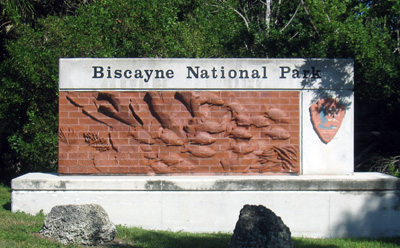 |
An entrance sign for the park displays a marine theme (Photo by Gerad Teague). |
At this point, it doesn’t look like Florida at all – more like the Midwest – as, aside from the occasional palm tree farm, the surrounding land has been clear cut, ostensibly for either crop plantings or development.
After a few miles, a line of foliage emerges on the horizon, signaling the periphery of the mangrove forest.
“This place is unreal,” Brown said as she steers the car into the parking lot. “I had no idea the ocean was this close.”
Today, we’ve come to go canoeing; because the park is more than 95 percent water, it seems like a fitting activity. We head into the office to rent a canoe, which ends up costing us $12 for an hours use.
According to Ranger Gary Bremen, more than half a million people visit Biscayne National Park each year, with the vast majority touring by boat rather than automobile.
| One of the picnic areas near the Visitor Center offers magnificent ocean views (Photo by Gerad Teague). | 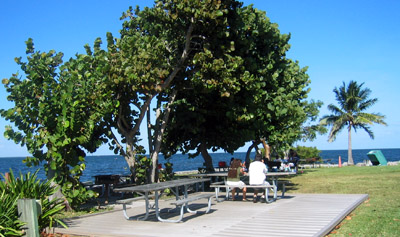 |
“We have 172,000 acres of protected land, but only one mile of road,” Bremen said.
Bremen also spoke at some length about the unique nature of the park, particularly in comparison to other popular tourist destinations in South Florida. He noted that it is considered one of the top scuba-diving destinations in the country.
“Take the more well-known Florida Keys. They’re mostly glitzy and developed,” Bremen said. “No other national park has what we have: coral reefs, undeveloped keys, a mangrove forest and over 10,000 years of history.”
As we approach the shore, there is a group of young men casting their nets. One wades into the water, net clutched firmly in hand.
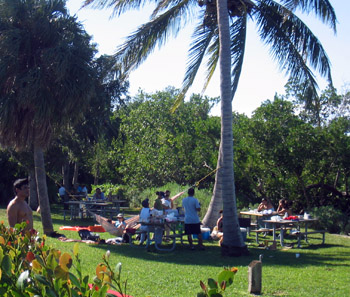 “There! At your feet!” shouts one of the men from the water’s edge.
“There! At your feet!” shouts one of the men from the water’s edge.
The net-wielding fellow surgical thrusts it into the water and reflexively jerks it back.
Success!
The group congregates around the catch, which happens to be a hapless crustacean – a crab, apparently – probably one of the many that reside in the shallow waters of Biscayne Bay.
Once we get our canoe into the water, it turns into a real battle. The wind is against us, so paddling requires even more effort than usual. We navigate close to the shore, toward the mangroves. A windsurfer zooms by.
“Look out!” he exclaims. The wind is pushing him hard to the left, as he leans right to create some counterbalance.
“Oh crap,” I hear him yell as he hits the water hard. Obviously, it’s a tough day to be out. Best to stay close to land.
The water is shallow, even 50 or so meters from shore.
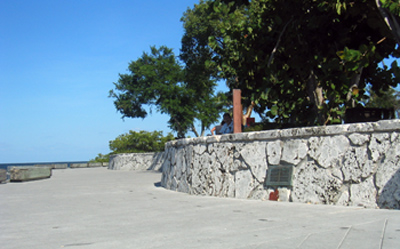 We can see small schools of minnows and similar diminutive fish darting about.
We can see small schools of minnows and similar diminutive fish darting about.
Navigating our way into the thick mangrove, a cluster of ibis scatters.
There is a wealth of wildlife here, clearly aware of the alien presence. It’s peaceful, though. No sounds or sights of the city, none of the hustle or stress.
The mangroves create an archipelago of sorts, as we float our way through. The foliage shelters us from the wind.
The sunlight manages to peek through the canopy, glistening and darting about on the water as the trees sway gently in the wind.
“Well, this is eye-opening,” said Brown, a New Hampshire native. “I’ve never seen anything like this. It’s like something you would see in the Caribbean, not the U.S.”
The waterways offer an expansive proving ground, but since we only have an hour, it’s time to cut it short. We flounder around in circles for a while, since neither of us possesses a keen sense of direction. Tiny fish scatter as we carve the water with our paddles.
As we make our way back and finally run ashore, we notice the crowd of windsurfers standing around their boards, talking about something or other. Emily and I pull the canoe ashore and a pair of the windsurfers approach hurriedly to assist us in putting the vessel back atop its rack.
| A student pauses on the boardwalk at the Visitor Center (Photo by Gerad Teague). | 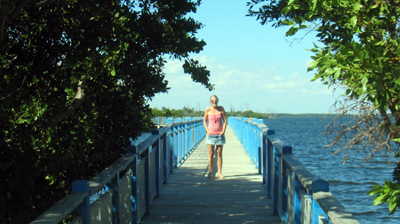 |
Nearby, a family appears to be in the midst of some celebratory event as they jubilantly crowd around a lit grill. A server doles out the typical fare, hot dogs and hamburgers, as excited children vie for the first serving.
It is still early, so we decide to explore a bit. The land element of the park is small; there is a visitor’s center, a modest-sized parking area, as well as a wooden path that buffers the land from the lapping ocean waters.
Emily leads me down the wooden platform, as young couple approaches from the opposite direction.
“We decided to take some time off to visit a friend in Fort Lauderdale,” said Kate Garland, a native of Newmarket, Mass. “Unfortunately he couldn’t take the day off so he recommended that we come visit [Biscayne]. What a day it’s been. We just finished snorkeling and coming from up north, you know, it’s a unique experience.”
Continuing on down the walkway, a snake can be seen slithering across. Emily shrieks and runs in the opposite direction. It’s obviously a snake of the harmless variety; as I approach it slithers away innocuously into the surrounding brush.
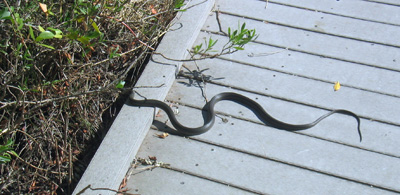 The wooden boardwalk eventually fades into a narrow dirt and coral rock isthmus.
The wooden boardwalk eventually fades into a narrow dirt and coral rock isthmus.
From here, the view is spectacular. The Miami skyline is hazily visible, as is Miami Beach, with both seeming to emerge seamlessly from the horizon.
A couple of older gentlemen are apparently busy at some task, as we approach the where the isthmus tapers into the sea.
One is busy carving a squid carcass into smaller, more manageable chunks, as the other attaches a piece of the dead mollusk to a fishing line.
“It’s the weekend, what better to do?” said Eddie Hernandez, a contractor from nearby Homestead. “The fishing here is very good. The swimming here is very good. I would recommend it to anyone who asked.”
| Sailboarders prepare their gear to to into the bay (Photo by Gerad Teague). | 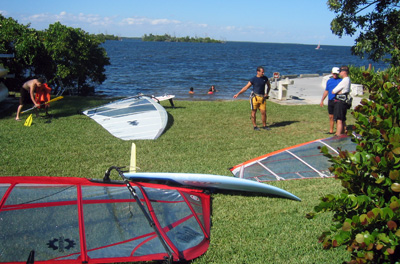 |
If You Go
- Hours: Water portion is open 24 hours a day. Convoy Point, location of the parks headquarters and visitor center, is open daily from 7 a.m. to 5:30 p.m. The Dante Fascell Visitor Center is open daily from 9 a.m. to 5 p.m.
- Contact: 305-230-7275; http://www.nps.gov/bisc.
- Directions: Take the Florida Turnpike south, to Exit 6 (Speedway Boulevard). Turn left from exit ramp and continue south to SW 328th Street (North Canal Drive). Turn left and continue to the end of the road. It is approximately five miles, and the entrance is on the left.
- Activities: Snorkeling, diving, boating, fishing, camping, picnicking.

Comments are Closed